Lavender plantation has officially begun along a 16-kilometre stretch of the Banihal–Qazigund National Highway, marking a major step toward beautification and aroma tourism in Jammu & Kashmir.
By: Javid Amin | November 7, 2025
A Fragrant Beginning in the Himalayas
The high-altitude air of Kashmir is about to smell sweeter. Along the 16-kilometre Banihal–Qazigund stretch of National Highway 44, rows of lavender plants have begun transforming the rocky slopes into a purple-hued landscape.
This marks the start of a landmark Lavender Plantation Project, an initiative by the National Highways Authority of India (NHAI) in collaboration with the CSIR–Indian Institute of Integrative Medicine (IIIM), Jammu. The project not only enhances the scenic charm of one of Jammu and Kashmir’s busiest travel corridors but also represents a model of eco-friendly development and aroma-based entrepreneurship.
The Highway of Blossoms: Project Overview
Location: 16-km corridor between Banihal and Qazigund, including the North and South Portals of the Navyug Tunnel
Plantation Volume:
-
23,000 lavender plants at the North Portal
-
29,000 lavender plants at the South Portal
Total Land Utilized: Over 200 kanals identified and cultivated under a formal MoU between NHAI and CSIR–IIIM.
The project falls under the broader Green Highways Mission, which aims to integrate environmental sustainability into India’s expanding road infrastructure. By planting lavender, a hardy and aromatic plant native to temperate climates, the project adds color, fragrance, and ecological stability to the mountain highway.
Why Lavender? The Science and Symbolism Behind the Choice
Lavender is more than just a pretty flower. Scientifically known as Lavandula angustifolia, this Mediterranean-origin aromatic herb is highly adaptable to Kashmir’s cool and temperate climate, thriving between altitudes of 5,000–7,000 feet.
Benefits of Lavender Cultivation:
-
Low maintenance: Requires minimal irrigation and resists common pests.
-
High yield potential: Each plant produces essential oil with strong global demand in cosmetics, pharmaceuticals, and aromatherapy.
-
Eco-friendly growth: Prevents soil erosion along slopes and supports pollinator populations like bees and butterflies.
Beyond its biology, lavender carries a universal symbolism of peace, calm, and renewal — qualities deeply resonant with Kashmir’s evolving tourism narrative.
Collaboration Between NHAI and CSIR–IIIM
This initiative was made possible by a strategic partnership between:
-
NHAI (National Highways Authority of India): Responsible for land identification, soil preparation, and infrastructure.
-
CSIR–IIIM, Jammu: Providing technical expertise, high-quality lavender saplings, and long-term maintenance guidance.
The project aligns with CSIR–IIIM’s broader “Purple Revolution”, launched under the Aroma Mission to promote lavender cultivation across Jammu & Kashmir. The initiative has already empowered hundreds of farmers in Doda, Reasi, Pulwama, and Budgam districts — turning barren land into blooming fields of profit and pride.
“The Banihal–Qazigund lavender plantation is a living example of how science, sustainability, and scenic beauty can come together,” said a senior IIIM scientist during a project briefing.
Empowering Local Communities Through Aroma Tourism
More than a beautification effort, this plantation opens new avenues for rural employment and entrepreneurship.
Local youth and farmers are being trained to:
-
Harvest and process lavender flowers.
-
Extract essential oils for cosmetic and therapeutic use.
-
Create value-added products like soaps, perfumes, candles, and herbal teas.
The growing popularity of “aroma tourism” — where visitors experience lavender fields, distillation units, and eco-homestays — could soon bring a new dimension to Kashmir’s travel offerings.
“We envision this stretch becoming a Lavender Hub — a tourist attraction in itself,” shared an NHAI official. “Imagine driving through a tunnel into a valley of fragrance and color.”
Aesthetic and Environmental Gains
The Banihal–Qazigund lavender project is strategically significant for several reasons:
-
Beautification of a Transit Corridor:
The 16-km stretch is among the busiest mountain sections on NH-44, linking the Kashmir Valley with the rest of India. Its transformation into a floral zone enhances both traveler experience and regional branding. -
Alignment with Green Highways Mission:
Lavender serves as an ideal species for eco-restoration due to its hardy nature and soil-binding roots. -
Climate Resilience:
The plant’s adaptability to temperature fluctuations helps prevent soil erosion and land degradation in fragile Himalayan terrain. -
Tourism Boost:
Travelers driving through the Banihal–Qazigund corridor can soon witness sweeping lavender meadows against the backdrop of Pir Panjal peaks — a natural spectacle expected to draw photographers, vloggers, and tourists alike.
Kashmir’s Growing Aroma Economy
This lavender initiative complements the ongoing Aroma Mission projects across Jammu & Kashmir. Since 2016, more than 3,000 farmers have adopted lavender cultivation across districts like Pulwama, Budgam, Kathua, and Reasi, earning substantial returns through essential oil sales.
The CSIR–IIIM has established processing units in key districts, allowing farmers to distill lavender oil locally and market it directly. On average, one hectare of lavender yields 40–50 kg of oil, fetching prices up to ₹10,000 per kg — making it one of the most profitable cash crops in the Himalayan region.
From Fields to Fragrance — The Business Potential
With the new plantation near Banihal, opportunities extend beyond agriculture.
Entrepreneurs can now explore:
-
Lavender-based cosmetics and wellness brands
-
Agro-tourism ventures and guided tours
-
Handcrafted souvenirs like dried lavender pouches and herbal sachets
-
Collaborations with perfumeries and essential oil companies
This fusion of eco-tourism and entrepreneurship positions Kashmir as India’s emerging hub for aroma-based industries.
A Highway Reimagined
The Banihal–Qazigund route has always been more than just a road — it’s a lifeline connecting two worlds. Now, it’s evolving into a symbol of Kashmir’s sustainable future.
From concrete to color, from transit to tourism, this 16-km lavender stretch encapsulates the idea that progress and beauty can coexist. For travelers, it promises not just a smoother ride, but a more soulful journey through nature’s palette.
Voices from the Ground
Local reactions have been overwhelmingly positive.
“Earlier, this land lay unused. Now, we’re growing something valuable and beautiful,” said Shabir Ahmad, a farmer from Qazigund. “Visitors stop to take photos. It feels like Kashmir is blooming again.”
Environmentalists have also praised the project’s long-term vision.
“If replicated across other highways, such plantations can significantly contribute to India’s green cover and local livelihoods,” said an ecologist from the University of Kashmir.
A New Tourist Attraction on the Map
As word spreads, the lavender highway near Banihal is expected to become a tourist hotspot — especially between May and August, when the plants are in full bloom.
Travelers heading toward Srinagar or Jammu can stop for:
-
Scenic photography sessions
-
Farm tours and lavender workshops
-
Local craft and oil-purchase stalls (under planning phase)
To plan your visit or lavender-themed itinerary, check out JKLTravels.com or KashmirTravels.in — both offering customized routes, eco-tour packages, and expert local guides.
A Model for India’s Future Highways
The success of the Banihal–Qazigund lavender project could inspire similar plantation models along other national highways — merging road infrastructure with green aesthetics and livelihood generation.
From Rajasthan’s desert roads lined with cacti to Himachal’s cherry trails, India’s highways could one day become corridors of fragrance and sustainability — and Kashmir’s lavender trail might just be where it all began.
In Bloom and Beyond
In a world rushing toward industrialization, this project reminds us that true progress also smells sweet. The lavender fields now growing beside the highway don’t just signify beautification — they symbolize hope, innovation, and harmony with nature.
As travelers drive through the Navyug Tunnel, emerging into the sunlight on the other side, they’ll soon be greeted by swaying lavender blooms — a gentle purple reminder that Kashmir’s beauty continues to evolve, one flower at a time.
Plan Your Visit:
For guided lavender field tours, aroma workshops, and customized eco-travel experiences in Kashmir, visit
👉 www.JKLTravels.com | www.KashmirTravels.in




